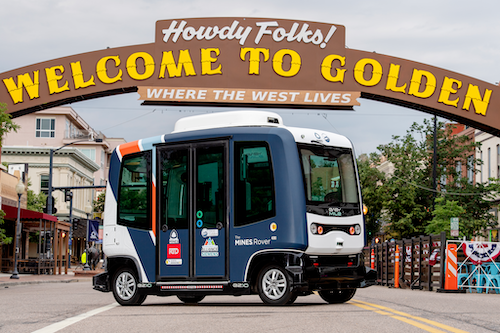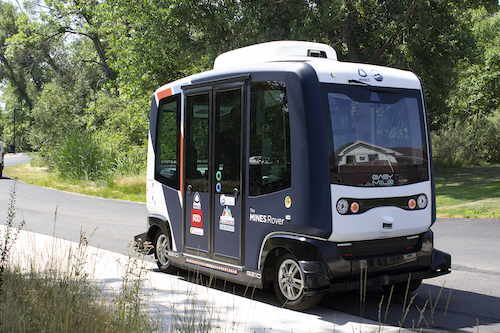Autonomous Vehicles Colorado (AvCo) announced the deployment of the nation’s largest fleet of low-speed, autonomous electric shuttles in multiple cities across Colorado.

Service in the first of three locations officially launched at Colorado School of Mines in Golden, Colorado. For at least the next year, the autonomous shuttle buses will connect Mines students, faculty, staff and the general public with key destinations in the city and around campus that currently lack convenient mobility options. The shuttles will safely navigate regular traffic using advanced sensors and technology, signaling a major step forward for the industry and the largest opportunity yet for the public to experience an autonomous public transit service.
The first phase of the program includes a fleet of nine driverless, zero-emission EZ10 shuttles from technology-provider EasyMile, powered exclusively by Siemens VersiCharge AC chargers, to connect Colorado School of Mines’ central campus, athletics complex, student housing and downtown Golden. The low-speed shuttle service in Golden is designed to operate in normal traffic and is named The Mines Rover. It is free of charge and available to the public. Each shuttle can hold six seated passengers, and each shuttle will also have an onboard customer service ambassador, a trained Mines student, who will engage with riders and take over manual control of the shuttle if necessary. The shuttle will operate along three fixed routes with designated shuttle stops and will arrive every 5-10 minutes along the routes.

The EZ10 shuttles are 100 percent electric, reducing the life cycle of climate-warming gases by 90 percent compared to similar, gasoline transit vehicles, which aligns with state and federal priorities to electrify the transportation sector. The shuttles safely navigate complex environments using advanced sensors, cameras and LiDAR that never get distracted, limiting the risk of human error that contributes to 94 percent of vehicle-related fatalities from the equation. The shuttles are ADA accessible and will show how people with disabilities can have enhanced mobility options from this technology.
Phases two and three of AvCo plan to launch in Greenwood Village and Colorado Springs, respectively, over the course of the next year to demonstrate the shuttles’ ability to operate in different environments, reduce carbon emissions associated with transit and fill different mobility gaps across the state.
“When people think of autonomous vehicles today, they see themselves riding alone – separated from other people and the overall transportation system. We want AvCo to change that perception by allowing people to experience how these technologies can maximize individual and societal benefits through integration with a shared public transit system,” said Tyler Svitak, Executive Director of the Colorado Smart Cities Alliance, the nonprofit at the center of the AvCo program. “What we learn here will help accelerate safer, cleaner, more accessible mobility for all.”
The City of Golden has been an essential partner to the success of this project, helping to design and support implementation of the autonomous transit service. Golden Mayor Laura Weinberg said of the project “The City of Golden is thrilled to be the first city in Colorado to offer zero-emission, autonomous microtransit. We thank our partners on this collaboration and the opportunity to advance our transportation sector community goals of 20% fossil fuel-free by 2030 and 100% fossil fuel-free by 2050.”
AvCo is the result of a partnership model involving multiple stakeholders, with major technology providers and consultants, including EasyMile, Siemens eMobility solutions, Stantec GenerationAV, Panasonic, and HxGN SmartNet; several cities and supporting organizations, including Colorado School of Mines, City of Golden, City of Colorado Springs, City of Greenwood Village, Denver South, Colorado Department of Transportation (CDOT); sponsors including McKinstry, LLC; and the Colorado Smart Cities Alliance, which is working to coordinate all stakeholders and project resources.

